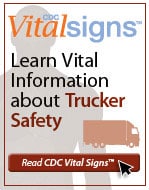Health – Long-Haul Truck Drivers

Health
Long-haul truck drivers may develop health problems because of their work environment. If they get a medical condition that affects their ability to drive, it could cost them their commercial driving license.
Our survey found long-haul truck drivers are more likely to smoke, be overweight, and are less likely to be physically active compared to other US workers.
Learn more about these results below and some resources to help address these problems.
Truck drivers were twice as likely to be obese compared to other US workers. Being obese, or overweight, can increase the risk of other health problems, such as:
- Heart disease
- Diabetes
- Hypertension
- High cholesterol
- Sleep apnea
- Lack of physical activity
Learn more about how you can prevent obesity in CDC’s Vital Signs on Adult Obesity.
- See our infographic: Obesity can take you off the road to learn more about these results.
We found truck drivers were twice as likely to smoke compared to other US workers. We also found smoking was three times higher among the female drivers compared to other women in the US workforce[1]. Smoking may be higher among truckers because it may help combat fatigue[2].
Smoking increases your risk of[3]:
- Cancer, including the lungs, bladder, blood, cervix, colon/rectal, kidneys, esophagus, liver, larynx, stomach, and pancreas
- Coronary heart disease
- Emphysema
- Stroke
The CDC offers tips on how to quit smoking.
If you smoke because you are trying to stay awake, here are some other ways you can combat fatigue:
- Get more than seven hours of sleep a night
- Drink more water
- Increase physical activity
- Increase omega-3 fatty acids, which can boost your alertness when taken regularly
- Loose extra weight by cutting down on portion sizes and trying to eat a well-balanced diet.
- Eat smaller meals more often during the day to help steady your blood sugar level.
[1] Birdsey J, Sieber WK, Chen GX, Hitchcock EM, Lincoln JE, Nakara A, Robinson CF, Sweeney MH. 2015. National survey of US long-haul truck driver health and injury: Health behaviors. JOEM. 57 (2); 210-216.
[2] Williamson A, Sadural S, Feyer AM, Friswell R. 2001. Driver Fatigue: A survey of professional long distance heavy vehicle drivers in Australia. Canberra, ACT: Australian Transport Safety Bureau. Accessed online December 18, 2013.
[3] CDC. Smoking and Tobacco Use webpage
Among those surveyed, three out of four truck drivers said they did not get the recommended amount of physical activity. We found only 1 out of 4 men and 1 out of 5 women drivers said they exercised for 30 minutes a day, five days a week. Getting at least 2 ½ hours of vigorous physical activity a week has been found to improve sleep, reduce stress, enhance alertness, and reduce the chance of car crashes.
High blood pressure, or hypertension, is when your blood pressure rises and stays high for a long time, which can lead to heart damage and other health problems. It can also raise your risk for heart disease and stroke, two leading causes of death in the United States.
We found 26% of truck drivers said they have hypertension, compared to 24% of the US working population.
Diabetes is a disease that occurs when your blood glucose, also called blood sugar, is too high. Blood glucose is your main source of energy and comes from the food you eat. Insulin, a hormone made by the pancreas, helps glucose from food get into your cells to be used for energy. Sometimes your body doesn’t make enough—or any—insulin or doesn’t use insulin well. Glucose then stays in your blood and doesn’t reach your cells.
Over time, having too much glucose in your blood can cause health problems, such as:
- heart disease
- blindness
- kidney failure
- low-extremity amputations
We found 14% of truck drivers said they have diabetes compared to 7% of the US working population.
Related Study Publications
For more details on the study and results, please see the journal articles, or contact us as eidinfo@cdc.gov

